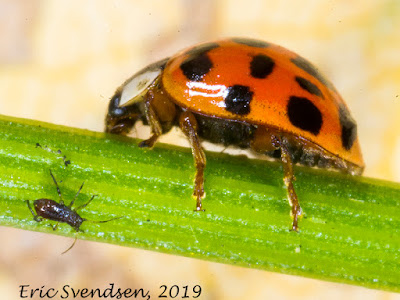Tarantula hawk wasp
 |
| Tarantula hawk wasp |
The answer, in western Arizona anyways, is the Tarantula hawk wasp. The wasp itself is a beauty to behold. Deep bluish black in colour with geometrically arranged antennae and a powerful thorax to drive their four wings, these are some of the largest wasps in the world. The adults themselves feed on nectar. I was out for a walk early in the morning in June, the temperature already in the high 80's (over 30° C) and I came across a number of them. They were busily engaging in flower feeding; taking from the bounty of the blooms. They seemed harmless enough, gentle giants peacefully visiting nectar boasting flowers. They weren't gathering for a hive though, they were preparing for a fight.
Tarantulas are crepuscular; staying in their burrows during the heat of the day and venturing out early evenings while it is still warm enough to be active. Some lay trip lines of silk that tell of a snack nearby while others go out and hunt for dinner. Either way, they overpower their victims decisively. Tarantulas do not make a web as other spiders do but instead use the silk as a proximity warning device or to line their burrows. They are ambush predators, jumping and capturing their prey from the safety of their burrow or upon discovering it in their wanderings.
It is when the tarantulas leave their burrows that they are vulnerable to attack. Although large, the wasp is dwarfed by the spider, yet it has an advantage the spider doesn't - it can fly. Searching for its target, the wasp spots its goal. The two meet - the spider sees dinner goes in for the kill. Surely this morsel will be as tasty as the last one. But something is different.
Instead of attempting to escape the wasp faces the spider and comes in, masterfully avoiding its fangs and strong legs. Then a sharp pain hits it; the spider has been stung - its thick armor no match for the sharp sting and paralytic poison it released. The spider can't move, but is still alive.
In a twist of fate the spider is returned to its burrow, or another prepared in advance, where it is laid to rest. Alive, still breathing, but unable to move at all. And a single egg is laid upon it. The hatchling larvae will enjoy spider until it is ready to pupate. The spider stays alive for a long time as the grub works it way through non critical systems, keeping its meal fresh for days to come. When it is all over, the young wasp metamorphs into an adult, and the cycle repeats itself. Another day, another spider.



Comments
Post a Comment